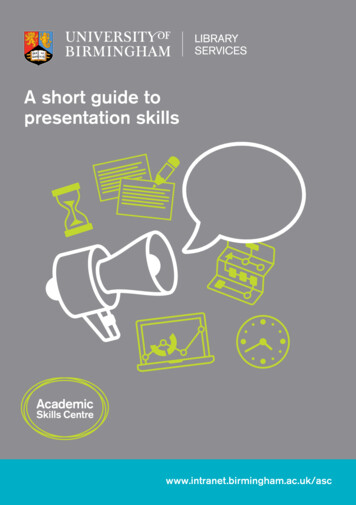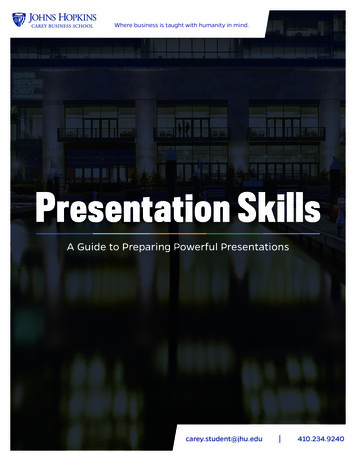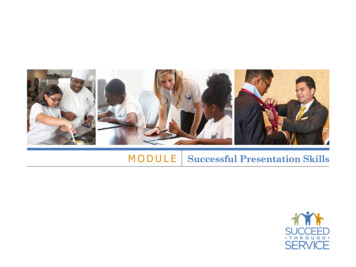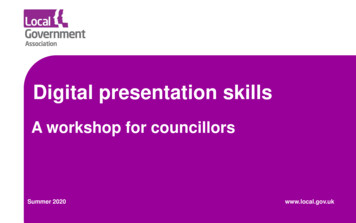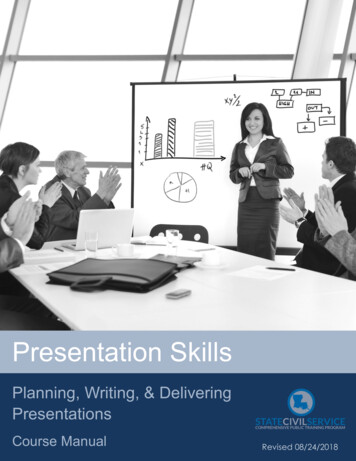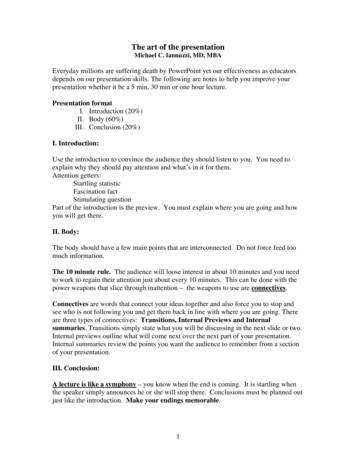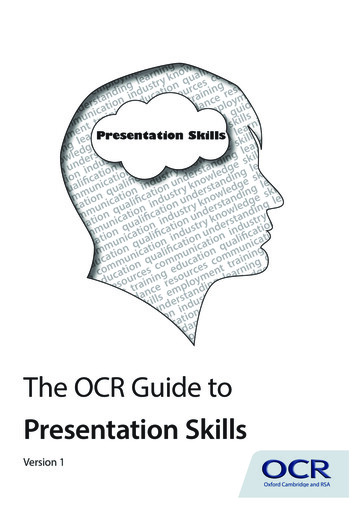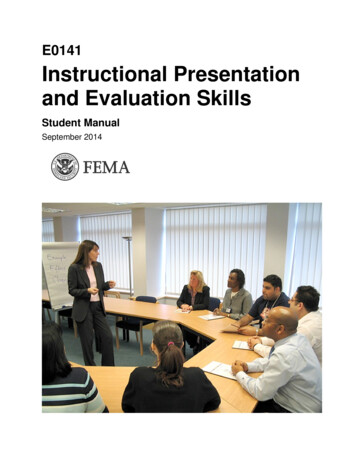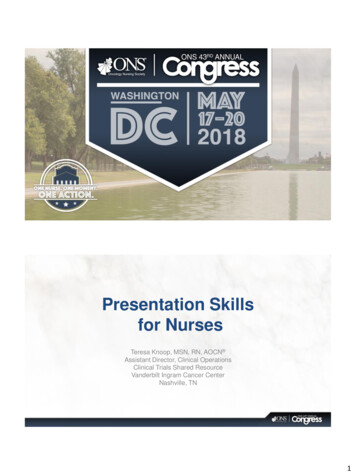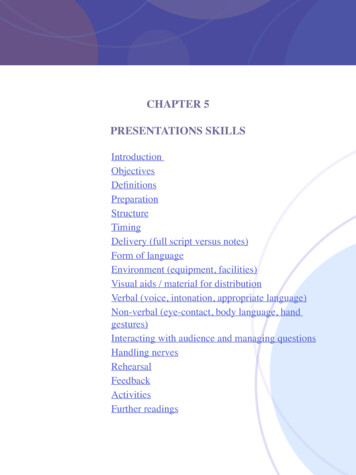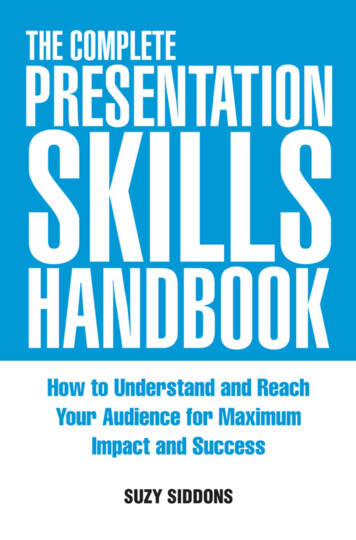
Transcription
ᔡ iTHE COMPLETEPRESENTATIONSKILLSHANDBOOKHow to Understand and ReachYour Audience for MaximumImpact and SuccessSUZY SIDDONSLondon and Philadelphia
ii ᔡPublisher’s noteEvery possible effort has been made to ensure that the information contained in thisbook is accurate at the time of going to press, and the publishers and authors cannotaccept responsibility for any errors or omissions, however caused. No responsibilityfor loss or damage occasioned to any person acting, or refraining from action, as aresult of the material in this publication can be accepted by the editor, the publisheror any of the authors.First published in Great Britain and the United States in 2008 by Kogan PageLimitedApart from any fair dealing for the purposes of research or private study, or criticism or review, as permitted under the Copyright, Designs and Patents Act 1988,this publication may only be reproduced, stored or transmitted, in any form or byany means, with the prior permission in writing of the publishers, or in the case ofreprographic reproduction in accordance with the terms and licences issued by theCLA. Enquiries concerning reproduction outside these terms should be sent to thepublishers at the undermentioned addresses:120 Pentonville RoadLondon N1 9JNUnited Kingdom525 South 4th Street, #241Philadelphia PA 19147USAwww.kogan-page.co.uk Suzy Siddons, 2008The right of Suzy Siddons to be identified as the author of this work has beenasserted by her in accordance with the Copyright, Designs and Patents Act 1988.ISBN 978 0 7494 5037 3British Library Cataloguing-in-Publication DataA CIP record for this book is available from the British Library.Library of Congress Cataloging-in-Publication DataSiddons, Suzy.The complete presentation skills handbook / Suzy Siddons.p. cm.Includes bibliographical references.ISBN 978-0-7494-5037-31. Public speaking. I. Title.PN4129.15.S56 2008808.5 1--dc222007044005Typeset by Saxon Graphics, DerbyPrinted and bound in India by Replika Press Pvt Ltd
ᔡ iiiContentsAcknowledgementsviiIntroduction11.Why Give a Presentation At All?Are presentations worth the effort?Benefits of a successful presentation5572.Setting ExpectationsThe delegate’s kitBooking venuesGreeting the delegates111215163.Researching Your Audience204.Audience BehavioursLearning dingResponding25252831323334345.How People Remember, What They ForgetThe four stages of memoryAssociations and differencesNumerical informationPrimacy and recency effect3838414345
iv ᔡ Contents6.Selecting Your Subject and Organizing Your InformationSetting SMART objectivesOrganization methods4748517.Writing the ScriptStructuring a scriptScriptwriting rulesStyle and vocabulary545558608.VisualsBrightness and afterimageLayout, templates and typefacesUsing presentation software to the full: the power of hyperlinksHow to prepare a hyperlinked showAdapting information for slide shows6565697072749.Staging the PresentationSpaceThe presentation areaLecternsLightingAcousticsOptional extras7676798080818110. Voice and Performance SkillsThe voice itselfDoes my accent matter?82869611. Nerves and Body LanguageCharisma, authority and influenceUse of spaceLearning to observeProxemicsDisplacement activitiesCreating rapportSpot the liarPutting body language together9810010110110310410510510612. Using Microphones and AutocuesWhat you need to know before you use a microphoneTypes of microphone and how to use themAutocues107107109111
Contents ᔡ v13. Rehearsals11314. Equipment and VisualsClicker/Wireless Pocket Presenter/Presentation RemoteUSB flash driveImage banksPresentation checklistAfter the presentation12012012112112112415. The Question-and-Answer SessionPreparing for the question-and-answer sessionTypes of questions to expectTracking the question-and-answer session12612713013316. Delivering the PresentationFirst impressionsCredibility – what the audience believesThe charisma recipeStarting with a bangYour final bow13513513513713814017. Technical Presentations and DemonstrationsTechnical presentationsSetting demonstration objectivesDemonstrationsThe sales cycle14114114414715118. Controlling the AudienceHandling interruptions15515719. Handling the MediaJust before an interview – taking controlPreparing for an interview – the five-step preparation processGetting help before an interviewThe actual interviewHandling discussionsOther hints and tips15816216316316616716920. Training People to Give PresentationsTraining yourselfTraining others170170173
vi ᔡ Contents21. The Role of the Master of CeremoniesThe MC’s duties before the presentationThe opening welcome and introduction17717717922. Following Up the Presentation18323. Alternatives to PresentationsSuccessful meetingsTasks necessary for any meetingsAttendees’ checklist for meetingsLeader’s checklistAttendees’ personal checklistOrganizer’s checklistTeleconferencing and video conferencing18618618719019119119219224. Handling Disasters194Appendix: Templates, Checklists and RemindersMaster checklistPersonal profileSelf-assessmentFeedback sheetsDelegate kitEvaluation formSample course questionnaireRehearsal checklistTemplatesHints and tips on preparing presentationsFlip chart questions and 1
ᔡ viiAcknowledgementsI would like to thank Samantha Warner for her invaluable help with theinformation about the latest technology in Chapter 14.My thanks also to the staff at Reflex Limited, who have for yearsprovided me with information about projectors and screens.Also, heartfelt thanks to my husband David Nickson, without whom
viii ᔡTHIS PAGE HAS INTENTIONALLYBEEN LEFT BLANK
ᔡ 1IntroductionThis book is for anyone who has to give a presentation of any sort to anykind of audience. Never let presentations or public speaking worry you oryour company again. Here’s the complete solution. Whether it’s presentingyour company internally or externally, giving good or bad news, selling,persuading, training or handling the media, this compendium of skillscovers sound working practices, exercises, checklists and case studies tomake sure that organizing and giving presentations and public speaking ofany kind becomes a pleasure and not a burden.Each section will contain: an introduction to the subject; backgroundinformation on the subject; best practice; hints and tips; step-by-stepguides; case studies and exercises where appropriate. Sample documents,slide and handout formats are in a separate appendix, as is a list of usefulpublications.The three essential ingredients of apresentationThe audienceWhy are they there? What do they want from the presentation? How dothey listen? What will they remember? What will turn them on or off, makethem comfortable or uncomfortable? What language do they speak? Howmuch do they know? What questions will they ask? What will they findhard to listen to? What are their business needs? How do you find outabout them? Can you analyse their response? What might make themhostile? How will you get feedback from them?
2 ᔡ The complete presentation skills handbookYou – the presenterWhy are you there? What do you want to achieve? What do you look like,what do you sound like? What will you do about nerves? How will yourehearse? How will you remember what to say? What is charisma? Howwill you handle questions? What will you do if they are hostile? How willyou keep your energy up? If you are being interviewed, how will youhandle this? Do you need a Chairman or Master of Ceremonies? Howwill you introduce yourself? Is there an efficient way of handling thetechnology?The presentation itselfWhat is it trying to achieve? What is it about? What are its limits? Whatvisuals or handouts will be needed, what technology is available? Howlong should it be? Will it need following up? How will the information itcontains be remembered? Which parts will be difficult or hard to understand? How will the script be prepared? What about the location andstaging?Each of these three ingredients is vital to a successful presentation – like athree-legged stool, when all the legs are there it is stable, but remove orshorten one of them and the whole thing collapses. No matter how wellconstructed the presentation is, if it is badly delivered it will fail; no matterhow well-delivered the presentation is, if it doesn’t make sense then it willfail. Most importantly of all, even if the presentation is perfect and thepresenter inspired and charismatic, if the audience isn’t interested orengaged, then the presentation will certainly fail.All these factors and many more will be covered in this book. By the endyou will have a tool kit for success, and presenting will never be the same.Before you read on, here is a questionnaire about how you feel youperform when presenting. Bear this in mind as you read on.Self-assessmentLook at the categories below and give yourself a score to show how goodyou consider your skills to be in each area.
Introduction ᔡ 3Table 0.1Self-assessment: structure of the presentationGoodFairPoorOh dear!FairPoorOh dear!FairPoorOh dear!OrganizationLogicInterest to the audiencePresentation of benefitsPositive startPowerful endingGood, concrete examplesLengthBalance between theory and realityTable 0.2Self-assessment: stance and postureGoodConfidenceGesturesEye contact with the audiencePersonal appearanceUse of the presentation areaTable 0.3Self-assessment: visual aidsGoodClarityInterestNumber of slidesAdded valueEquipment handling
4 ᔡTHIS PAGE HAS INTENTIONALLYBEEN LEFT BLANK
51Why Give a PresentationAt All?‘Presentation’ is a very inexact term – it covers everything from your firstjob interview to a retirement speech, from a standard sales pitch to a healthand safety lecture, a progress report to a project team to an appearancebefore a tribunal – anything that involves speaking to an audience of morethan one or two. So why do we do it – is there a compelling business reasonfor one person to spend the time and effort to put a presentation together –and more importantly why a group of busy business people should sit andlisten to that person?Presentations are an extremely expensive way of getting your messageacross. Well-paid and high earning sales personnel may be worth at thevery least 1 per minute. Imagine then, an audience of 20 salespeople,listening to a half-hour presentation. This is 600 worth of time. If you thenadd up all the time that they spend listening to presentations (often up tofour hours per week) you get to the massive figure of just over 9,000 peryear per person. This is 9,000 worth of time that they could have spentselling. Add this to the amount of time that is spent preparing, deliveringand following up presentations, we are looking at a very significant sumindeed.Are presentations worth the effort?It may seem strange to begin a book on presentation skills by questioningthe very need for presentations at all. This, however, is something that isnot done rigorously enough. All too often we deliver presentations withoutthinking through the genuine benefits that this particular method ofpassing information to others should bring, let alone concerning ourselveswith what the audience wants to gain from the presentation.
6 The complete presentation skills handbookTable 1.1Good and poor reasons for giving a demonstrationGOOD REASONSPOOR REASONS If you need to communicate timecritical information to a large groupof people Because we always havepresentations on Thursdays If you need to persuade an audienceto make a choice, change theirmind, take a set of actions or passon information to others, and youneed to do it in person If the audience is interested,concerned or needs to hear whatyou are going to say If you need to teach skills or giveinformation cost effectively to morethan three or four people at once If you have a clear set of objectivesfor the presentation If attending the presentation will actas a bonding exercise for the peopleinvolved If you have the time, energy andcommitment to make thepresentation If the information you are giving isalready known to the audience andthe presentation neither reinterprets it or puts it into a newcontext If the audience isn’t interested inwhat you are going to say, ordoesn’t need to hear it. If the audience doesn’t know whythey are there, or you’re not surewhy you are presenting If you have no objectives for thepresentation If the audience feel they have betterthings to do If you are in any way half heartedabout the presentationThere are several major factors to consider before you start to spend anytime on preparing a presentation. Ask yourself the following questions: Is there a better way of getting this information across? Could I use email, a written report, a short meeting, a conference call or anothermethod?Have I got all the information I need?How much will this presentation cost and is it cost-effective?What is this presentation for? What will the audience do, think and feelafter they have heard the presentation?If the answers are ‘yes’, ‘no’, ‘too much’ and ‘no idea’ then you should seriously consider whether a presentation is the best method in the first place.If you think about all the presentations you have sat through in your career,I wonder if anyone could honestly say that every one of them was worththe time and effort involved?
Why give a presentation at all? 7A good presentation contains many of the same constituents as a goodbook. The readers should be curious about the subject. The writer should beat least literate, if not magnificent. The chapter list should be interestingand understandable. The words should be the best possible. The appearance of the book should be impeccable. The reader should have somewhereto sit and read comfortably. The typeface should be easy to read, and it ishelpful to know where and when they can find the book in the first place.The most important factor in the success of both a book and a presentation is the attitude of the consumers. Just as you cannot force people to readsomething they neither like nor need, so you should never force-feed anaudience with indigestible, unnecessary, uninteresting or irrelevant information. The audience’s attitudes, responses, reactions and needs throughout the presentation are of paramount importance – in fact, without anaudience you have no presentation.So is there a perfect recipe for a presentation? Can a presenter realisticallyexpect to please all the audience all the time? Of course not. What an effective presenter can expect to do is to put the message across in a way thatinvolves the audience both intrinsically (by making them react, think, andcompare) and extrinsically (by making them discuss, find out more or takecertain courses of action). An effective presenter can also expect to leaveeach member of the audience feeling that they have learned something thatis of use to them, in a way that made the information real to them personally and with a clear sense of what the next step will be.Of course, the presenter cannot do this without knowing a considerableamount about the people who are going to be in the audience.Benefits of a successful presentationWhen people listen to presentations, they hope they will hear things thatwill do some of the following:Table 1.2What a presentation should achieve for the audience Make money or save money Help them to be unique Save time or effort Help them to protect their reputation Make them comfortable Improve their health Save them pain Make them popular, famous Attract the opposite sex Help them to take advantage ofopportunities Help them to gain control Keep them safe Gain them praise Conserve their possessions Increase their enjoyment Satisfy their curiosity
8 The complete presentation skills handbook Protect their family/business Make them stylish Satisfy their appetites Allow them to copy others Give them beautiful things Give them good ideas Help them to choose betweenoptions Confirm their expertise Solve problems for them Amuse them Give them am inside view Give them an expert vocabulary Confirm their decisions Help them to take advantage ofopportunities Help them to avoid criticism Open new markets for them Help them to avoid troubleIf what you are going to say doesn’t do any of these – don’t say it.Here’s an example of a pointless presentation. The presentation wasgiven every half-hour to small groups of possible buyers at a huge motorshow by the chief engineer of Vitessimissimo Motors, a very prestigiousmanufacturer known for high-quality, high-performance sports cars. Thecar itself was slowly rotating on the display stand along with a lissome ladyand a great number of brochures. The stand was also fully staffed withsalespeople with a large screen at one side showing a looped video of thecar speeding along roads in the Tuscan hills. The brochures contained thefollowing information with very good photographs of the car.The presenter had 10 slides, each of which contained the information inone of the rows of the specification and nothing more. The presentationtook about five minutes, after which the sales force moved among the audience to answer any questions. The presenter was a brilliant engineer, butsadly, not the world’s greatest speaker. His script consisted of reading everyword on each slide slowly. When asked why he was giving the presentaTable 1.3Specifications of the Vitessimissimo Gran TurismoEngine ceGearboxIncludedDate of release4244cc, eight cylinders399bhp / 7100rpm / 339lb ft / 4750 rpmSix speed automatic0–62mph: 5.2sec / Top speed: 177mph19.2mpg (combined cycle) / 345g/km 84,500Conventional automatic transmissionSatellite navigation system, 4 cup-holdersOctober
Why give a presentation at all? 9tion he told us: ‘All the other stands have live presentations, so we thoughtwe should as well.’Now here’s an example of where a presentation was really needed:The venue is a central London Hotel. The conference is for directors ofbuilding companies in the south-east, some of whom (but not all) belong tothe SE Builder’s Association. Next month, legislation is proposed to ensurethat any building projects in flood plains, brownfield sites or green beltland follow a set of new and extremely complicated criteria. The speaker isthe chairman of the SE Builder’s Association who has been closely involvedin the drafting of this new legislation. His association runs an extremelyuseful interactive website that has highlighted three major concerns andshown that there is much confusion about exactly how this legislation willaffect planning permissions. He intends to: give a general overview of the new legislation with advice about whereto find out more about it;address the three major concerns;discuss the impact of this legislation on building costs, time scales andlogistics;take questions.His objectives are: to clear up any misunderstandings;to gain new members in the association;to get feedback on any parts of the legislation that are unacceptable tohis members.Not only has he his own set of objectives, he has also asked the attendees(via the website) what they want to hear about, and has set his agendaaccordingly. There is every possibility that his presentation will be useful,extremely interesting to the audience and therefore successful.ExerciseScenario: a medium sized retail store has one department selling smallelectrical goods (irons, toasters, mixers, coffee machines, electriccarving knives and so on). A manufacturer’s rep wants to come andgive a presentation to show the new products that his company isproducing. The department has an electrical buyer, two assistants anda storekeeper who are all frantically busy.Is a presentation the best way to get the (simple) information aboutthe new products across? What else could be done?
10 The complete presentation skills handbookExerciseScenario: an insurance company is changing the cost of their policiessignificantly. This is partly due to changes in the law and partly due tothe rising claims caused by what appears to be climate change.Undoubtedly these changes are going to make the policies harder tosell, and there are legal and financial implications that are complicatedand hard to understand.The sales force is in the dark about this and naturally worried. Is apresentation to the sales force called for? What else could be done toget this information across quickly and effectively?As with every consideration in this book, the audience’s needs are paramount and even the slightest suspicion that you might be wasting the audience’s time should give you pause for thought before going to all the effortrequired (on both sides) for a presentation.SummaryThe three ingredients for a successful presentation are the audience, thecontent of the presentation itself and the presenter – of these, the startingpoint should always be the audience. If you consider their needs and interests, you can’t go wrong.
ᔡ 112Setting ExpectationsWhen does the presentation begin? When you step onto the stage and startto speak? Or is there anything you can do to predispose the audience tolisten actively and positively?There is indeed a great deal that you can do to set the audience at ease.For those of you who are used to organizing and giving presentations theseconsiderations will seem like self evident truths, but as with most things,the devil is in the detail and the sheer scale of logistics for a presentationcan often scupper the project before the audience even arrives.Take this scenario. You are a wheelchair-bound consultant at a majorLondon hospital. You have been asked (by your boss) to attend a conferenceat the London headquarters of a major drug manufacturer. You have nevervisited these headquarters. The presentation he wants you to attend is at 10am on Monday 13 October. Your field of interest is rheumatology. You knowthat this manufacturer has developed a drug that can successfully treatarthritis. What else do you need to know?Let’s start with the basics:ᔡᔡᔡᔡᔡᔡᔡᔡᔡᔡᔡWhat is the address exactly?Whereabouts in the building will the presentation take place?Does your enterprise have a contact there?What is their phone number and e-mail address?How can you get there and how long will it take?What about parking?What about disabled access?How long will the presentation last?Will there be time for questions?Are there any other presentations taking place with this one?Is there an agenda?
12 ᔡ The complete presentation skills handbookᔡᔡᔡᔡᔡWho else will be attending?What is the presentation about – exactly?Who will be speaking and what are their credentials?What will you gain from this presentation?Will lunch and refreshments be provided and is there a vegetarianoption?If you don’t get answers to all these questions, you will be uncomfortableand unprepared, and therefore not positively in favour of attending. Whatyou really need is for the people organizing the presentation to send you adelegate’s kit.The delegate’s kitTable 2.1A sample delegate’s kitPage A: Title pageConference Title: Living with ArthritisSponsored by: The Arthritis Trust and Jollydrugs Plc.Location: Conference Room 1, 3rd Floor West.Address: Jollydrugs House, 14 Ashbourne Way, Notting Hill, London W8 XXX.Date: Monday 13 October 2008.Duration: 9.00 am–4.30 pm.Contact: Maria Grey, Tel: (020) 7222 444 Email: mariag@jollydrugs.co.uk.Page B: Location map and directions page(Include a location map here.)BY ROADSouthbound motorway exitbeyond Junction 13 ORNorthbound motorway exit atjunction 15Take the A2111 to Notting Hilland turn into Ashbourne Way.Jollydrugs House is the tallbuilding opposite the policestation.BY RAILTake a train toPaddington Station;Take the Underground toNotting Hill;Turn left at the station, second rightand Ashbourne Way is on your right.It is a three minute walk fromNotting Hill station.BUSES27, 27a, 204, 311PARKINGThere is a large reserved parking areaand easy level access to JollydrugsHouse.Disabled parking is provided for10 cars.BY TAXITaxis available at PaddingtonStation.
Setting expectations ᔡ 13BY AIRLondon HeathrowMeeting rooms: There is a lift to the main conference room and a wheelchair lift toall other meeting rooms.Dining room and coffee lounge. Both of these rooms are on the ground floor withexcellent access and our dining room tables have been adapted to be wheelchairfriendly. There is always a vegetarian option available at meals.Hearing aid loops: There is a hearing aid loop in the conference room.Page C: Programme PageTIME8.45 am9.00 amEVENTRegistration and coffeeWelcome9.10 amIntroductionDiagnosing the problem10.00 amPresentation‘Miraclextra, the drug ofthe future’CoffeeEtc.10.50 amEtc.SPEAKERDr Maria GreyChief of ResearchJollydrugs PlcProfessor Jack KetchManaging DirectorThe Arthritis TrustDr Phillippa BrainChief Research ChemistJollydrugs PlcEtc.There will be time for questions at the end of each presentation. Handouts will beprovided.Page D: Delegate list pageDelegate nameDr Betty Ford CompanyGlaxcombe Plc.Page E: Biography pagesDr Phillippa BrainAs Chief Research Chemist of Jollydrugs Plc, Dr Brain has been working for sevenyears with her team on the development of Miraclextra. Her sectors of research alsoinclude tracking the side effects of arthritis drugs in general and specific work on Papers published include: ‘Arthritis and Ageing ’Her presentation ‘Miraclextra, the drug of the future’ will cover thedevelopment and testing of the new drug. Results so far, acceptable side effects andcontraindications At the end of the presentation, delegates will be fully up-to-date with the latestresearch in this field.
14 ᔡ The complete presentation skills handbookPage F: Presentation page(List the slides that will be used in the presentations.)Page G: Evaluation form: generalThe Arthritis Trust would be grateful if you would take a few minutes to completethis form and hand it in at the end of the conference.How useful do you think this conference has been?Not at all12345Very6How did you rate the quality of the conference?Poor12345Excellent6Do you feel that the conference will be of use to your company?NoYes123456Page H: Speaker evaluationSpeaker name:Was motivated and enthusiastic about the topicPresented the material in an informative mannerAny other comments:Speaker name:Was motivated and enthusiastic about the topicPresented the material in an informative mannerAny other comments:Page I: Conference environment 23344551122334455333444555666What I found most useful from the conference:What I found least useful from the conference:Please give any other comments that you feel would help us to improveconferences in the future.Pages F, G, H and I can be given out at the actual presentation.A carefully prepared delegate’s kit will allay any pre-attendanceconcerns that the attendees may have and should predispose them to thinkpositively about what they are going to listen to. There are other things thathelp with this too:
Setting expectations ᔡ 15ᔡᔡᔡᔡᔡᔡᔡname tags for the delegates and speakers;name plates for the speakers on the platform;a seating plan (if appropriate);water and mints;seating plans for lunch;clear signage for the conference room, coffee break room, rest roomsand restaurant;paper and pens for each delegate.Never underestimate the importance of making the logistics of any presentation as clear as possible. If the audience doesn’t feel that their needs havebeen considered they may well have a negative mindset before the presenter has even started speaking.Booking venuesThe other side of the coin is how the organizer goes about setting up a presentation. Here are the things that you need to think about when organizinga conference or set of presentations at an external venue. The same criteriaalso apply when you are giving a presentation in-house.ᔡᔡᔡᔡᔡᔡᔡᔡᔡWhat are the charges or cost per delegate?Where can you get information on prices and/or an estimate?How well equipped are the conference rooms? You will need a range ofequipment. Decide what you need for the venue to set up your room asrequired. Ask to see a full equipment list.What are the settings like in the conference rooms? The conferenceroom should be laid out in an appropriate style – theatre, classroom,board room, café, etc.Is it possible to have a working lunch? Is advance notice necessary?What capacity is the conference room?Where is the conference room located? Do they have a location map?What are the parking facilities? How far is the venue from public transport?What kind of food is on offer? Are special diets also available?Is secretarial help provided? Are there any facilities for those withdisabilities?
16 ᔡ The complete presentation skills handbookᔡᔡᔡWhat facilities are there for the organizer? Will they provide you with awelcome desk, phone line and computer/internet modem line? Willthere be a manned reception desk and how will people register?Do mobile phones work in the venue?Can they provide overnight rooms for the conference organizer and thefirst speakers?Greeting the delegatesThere is a comforting ritual that happens when people greet each other. It’sa natural pattern – we do it almost instinctively and it clearly signals thatwe are pleased to see our visitors and that we welcome them. It’s our wayof easing the passage between arriving as a ‘stranger’, i.e. someone invitedonto another person’s ground, to feeling included in what is going tohappen there.If done well, it is the start of a successful relationship because it makesour visitors feel special. If done badly or left out it makes the ‘stranger’uncomfortable and often hostile.This is how it goes: there are seven stages to the ritual.ᔡᔡStage 1 – The invitation and Stage 2 – the directionsThese should be as personal as possible. The initial invi
2 The complete presentation skills handbook. Introduction 3 Good Fair Poor Oh dear! Organization Logic Interest to the audience Presentation of benefits Positive start Powerful ending Good, concrete examples Length Balance between theory and reality
